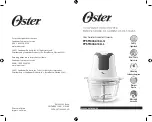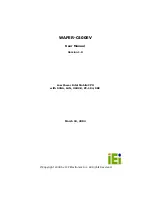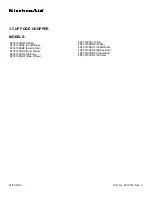
14
at room temperature.
Therefore, only attempt
to slice or shred mozzarella
when well chilled, and
Parmesan when at
room temperature.
TECHNIQUES
FOR KNEADING
YEAST DOUGH
WITH THE
POWERPREP
®
METAL DOUGH
BLADE
The Premier Series
14-Cup Food Processor is
designed to mix and knead
dough in a fraction of the
time it takes to do it by
hand. You will get perfect
results every time if you
follow these directions.
NEVER TRY TO
PROCESS DOUGH
THAT IS TOO STIFF TO
KNEAD COMFORTABLY
BY HAND.
There are two general
types of yeast dough.
Typical bread dough is
made with a flour mix that
contains at least 50% white
flour. It is uniformly soft,
pliable and slightly sticky
when properly kneaded. It
always cleans the inside of
the work bowl completely
when properly kneaded.
Typical sweet dough
contains a higher propor-
tion of sugar, butter and/or
eggs than typical bread
dough. It is rich and sticky
and it does not clean the
inside of the work bowl.
It requires less kneading
after the ingredients are
mixed. Although 30 sec-
onds is usually sufficient,
60 to 90 seconds gives
better results if the
machine does not slow
down. Except for kneading,
described below, the
processing procedures and
use of the DOUGH button
are the same for both types
of dough.
Machine capacity
Recommended maximum
amount of flour is 6 cups
of all-purpose flour or
3-1/2 cups of whole-grain
flour. If a bread dough calls
for more than the recom-
mended amounts of flour,
mix and knead it in equal
batches. Do the same for
sweet doughs that call for
more than 3-1/2 cups of
flour.
Using the right blade
Use the metal dough blade
when the recipe calls for
more than 3-1/2 cups
(17-1/2 ounces) (875 ml)
of flour. Use the metal
chopping blade when a
recipe calls for less than
3-1/2 (875 ml) cups of flour.
Because the metal dough
blade does not extend to
the outside rim of the work
bowl, it cannot pick up all
the flour when small
amounts are processed.
Measuring the flour
It’s best to weigh it. If you
don’t have a scale, or the
recipe does not specify
weight, measure by the stir,
scoop and sweep method.
Use a standard, graduated
dry measure, not a liquid
measuring cup.
With a spoon or fork, stir
the flour in its container. Do
not measure flour directly
out of the bag; it is too
packed to get an accurate
measure. With the dry
measure, scoop up the
flour so it overflows. With a
spatula or knife, sweep
excess flour back into the
container so the top of
the measure is level.
Do not pack flour into
the dry measure.
Proofing the yeast
The expiration date is
marked on the packages.
To be sure your yeast is
active, dissolve it in a small
amount of warm liquid
(about 1/3 cup [75 ml] for
one package of dry yeast).
The temperature of liquid
used to dissolve and
activate yeast must be
between 105° and
120°F(40°C and 48°C).
Yeast cells are not activat-
ed at temperatures lower
than this and they die when
exposed to temperatures
higher than 130°F (54°C).
If the recipe includes a
sweetener like sugar or
honey, add a teaspoon with
the yeast. If no sweetener
is called for, add a pinch, or
add a pinch of flour. The
yeast won’t foam without it.
Let the mixture stand until it
foams, up to 10 minutes.
Processing dry ingredients
Put the flour in the work
bowl with all the other dry
ingredients. If the recipe
calls for herbs, oil or solid
fats like butter, add them
with the flour. Turn the
machine on and let it run
for about 20 seconds.
(Cheese, nuts and raisins
may be added with the dry
ingredients or during the
final kneading. To leave
them almost whole, add
them 5 seconds before you
stop kneading. For a finer
texture, add them sooner.)
03CU13537 DLC-2014N IB-5056 10/2/03 11:34 AM Page 16
Содержание DLC-2014N - PowerPrep Plus Food Processor
Страница 2: ......
Страница 23: ...21 NOTES...









































